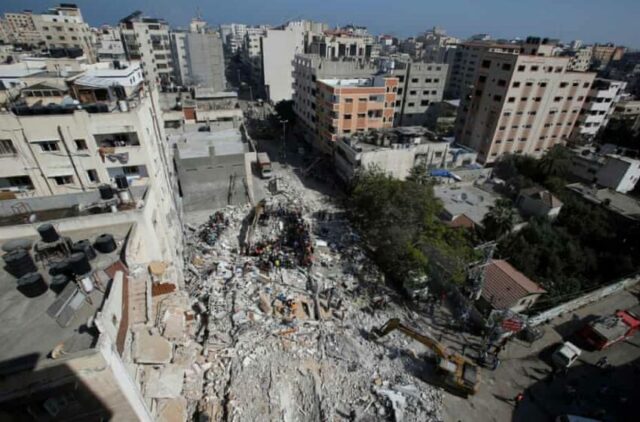Her hair is matted with rubble dust. Bare feet poke out from pink tracksuit bottoms. Blood from a head wound streaks over her eye and down her face.
But Suzy Eshkuntana is alive, pulled out of the rubble of her family’s home seven hours after it was hit in an Israeli airstrike in the middle of the night. Her four siblings and her mother were killed.
Later, in hospital and reunited with her injured father, the horror of the night is etched across Suzy’s face. At six years old, this is her first experience of war – but Gaza’s history suggests it won’t be her last.
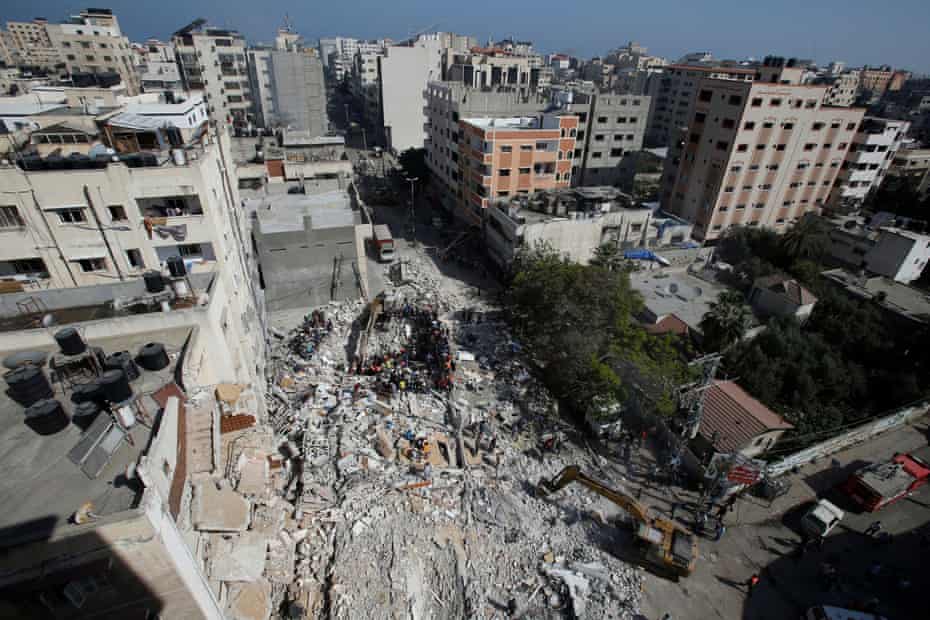
-
Rescuers search for people in the rubble of a building at the site of an airstrike in Gaza City, and below – carry Suzy Eshkuntana from the same site. Photographs: Mohammed Salem/Reuters

In the nine-day-old conflict between the Israel armed forces and militants in Gaza, at least 63 children have been killed and hundreds injured, according to Gaza health officials. In one incident, eight children from one extended family died as they were sleeping in an airstrike on the densely populated Shati refugee camp on Saturday. The Israeli military said it had targeted Hamas officials.
Thousands of families have fled their homes, seeking shelter in UN-run schools or with relatives in parts of Gaza thought to be at lower risk from airstrikes. Hundreds of families have lost their homes altogether: what was once a place where children played, ate, did their homework and slept is now a pile of rubble and twisted metal.
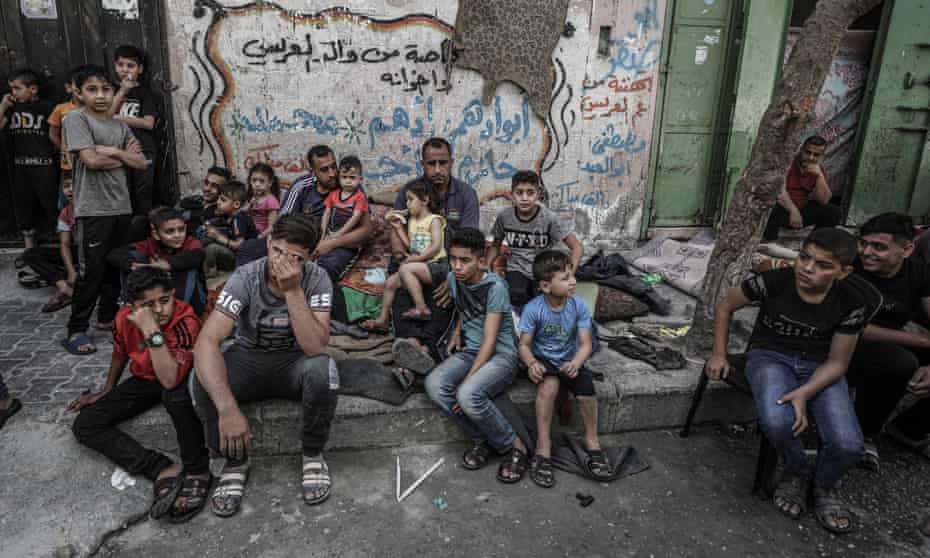
-
The children of the al-Deyri family after their home was demolished by an airstrike in Gaza City. Photograph: Ali Jadallah/Anadolu Agency
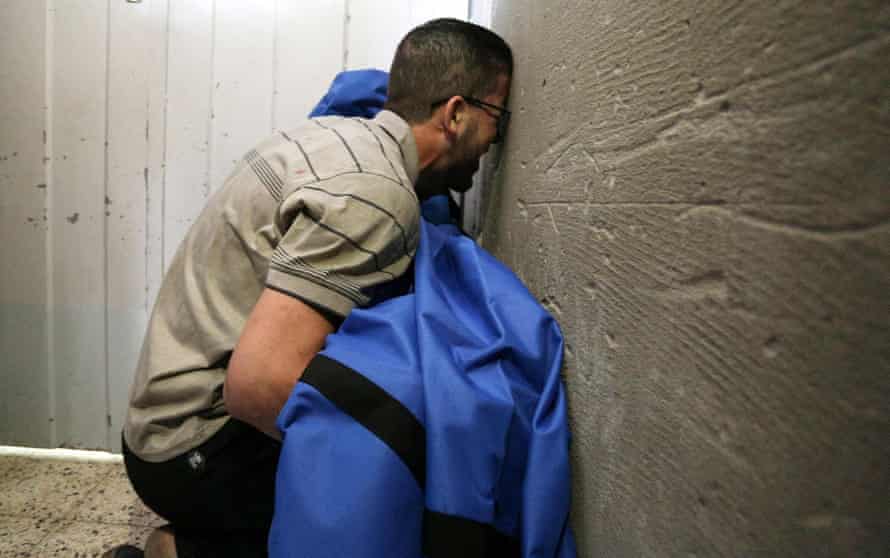
-
The father of 12-year-old Rahaf al-Dayer holds her covered body at al-Shifa hospital in Gaza City, after she was killed in an Israeli airstrike that destroyed the upper floors of a commercial building and caused damage to the nearby health ministry and a clinic. Photograph: Anas Baba/AFP/Getty Images
In Gaza, a tiny coastal territory just 25 miles long and at most seven miles wide, enclosed by walls and fences, there is no escape from the terrifying sound of explosions and the fear that any moment could be your last. “The scale of violence is massive,” said Unicef, the UN children’s agency, at the weekend. “Children are bearing the brunt of this escalation.”
For children in their early teens, this is the fourth war they have lived through. All those under the age of 13 have lived their entire lives under Israeli blockade, with restrictions on movement, naval warships patrolling the seas and military aircraft and surveillance drones in the skies above.
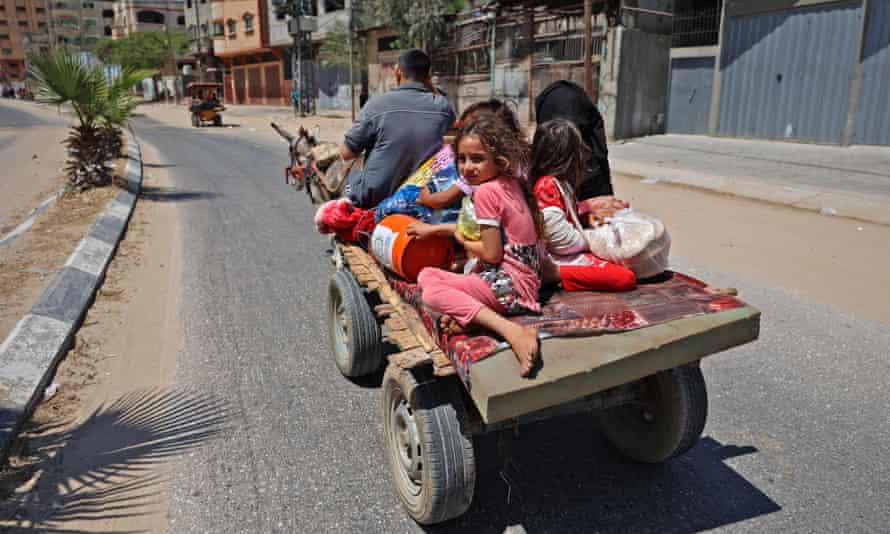
-
A Palestinian family on a carriage pulled by a donkey in Beit Lahiya in the northern Gaza Strip, fleeing to safety last Friday. Photograph: Mohammed Abed/AFP/Getty Images
These children have also spent their entire lives under the rule of Hamas, the Islamist faction that seized control of Gaza in 2007 after it won elections the year before. Over the years, Hamas has cracked down on dissent, intervened in the school curriculum, enforced its strict moral codes and fostered a culture of hatred and violence. Hamas rockets often fall within Gaza’s borders, sometimes causing destruction, injuries and deaths. Militant operations and infrastructure make civilians a target. It’s a tough environment in which to grow up.
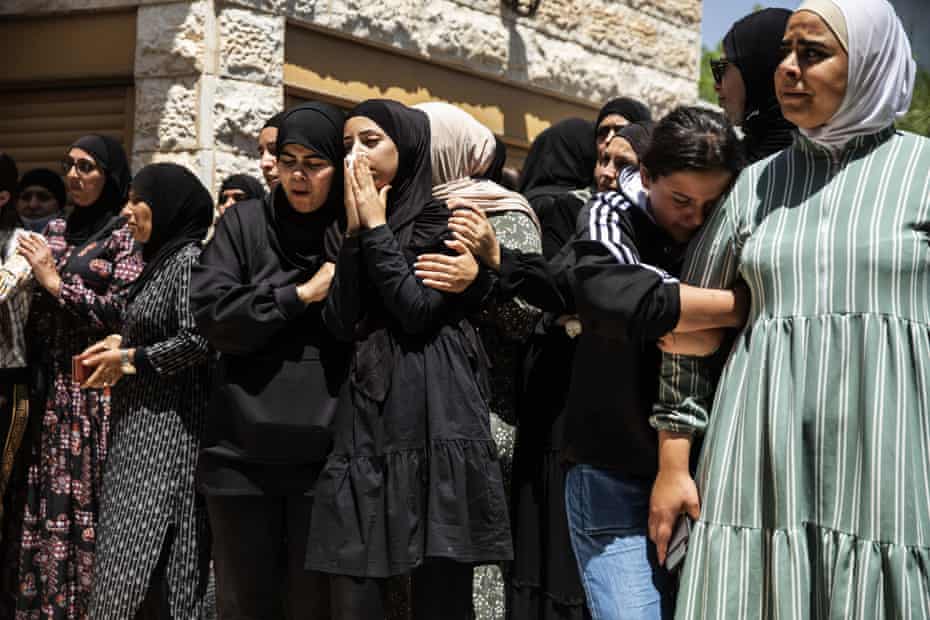
-
The funeral of the Israeli Arab Khalil Awaad and his daughter Nadine, 16, in the village of Dahmash near the Israeli city of Lod. A rocket fired from Gaza hit their house and killed both of them. Photograph: Heidi Levine/AP
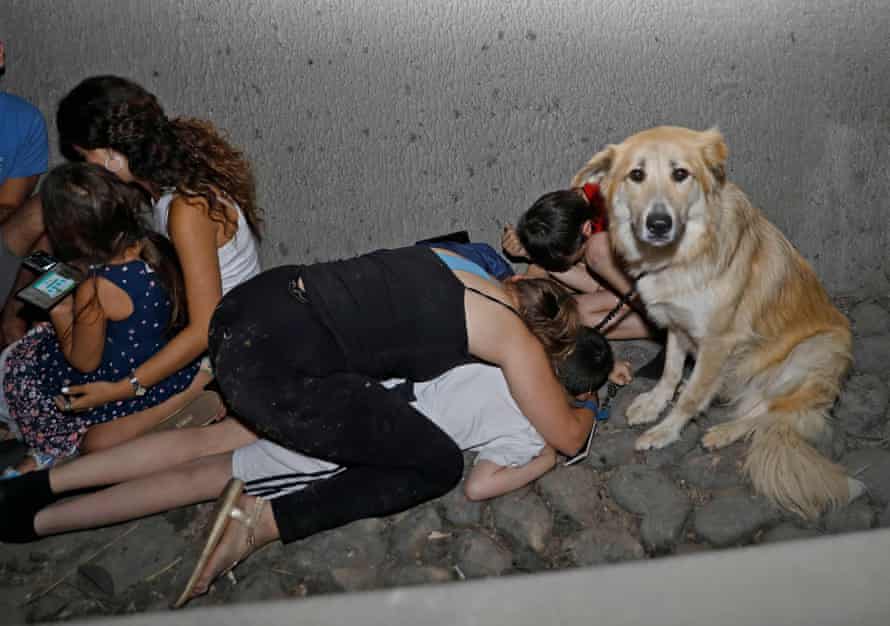
-
Israelis take cover under a bridge in Tel Aviv. Photograph: Gil Cohen-Magen/AFP/Getty Images
The first war between Israel and Hamas in 2008-09 lasted three weeks and ended with about 1,400 Palestinians – including almost 300 children – dead. The next war came in 2012, lasting a week and leaving 174 Palestinians, including 33 children, dead, according to the UN.
Two years later, a third war lasting 50 days ended with more than 2,100 Palestinians, including almost 500 children, dead. About 1,000 children sustained injuries resulting in permanent disability, according to Defence for Children International. The UN estimated that in the month following the ceasefire, about 373,000 children required psychosocial support.
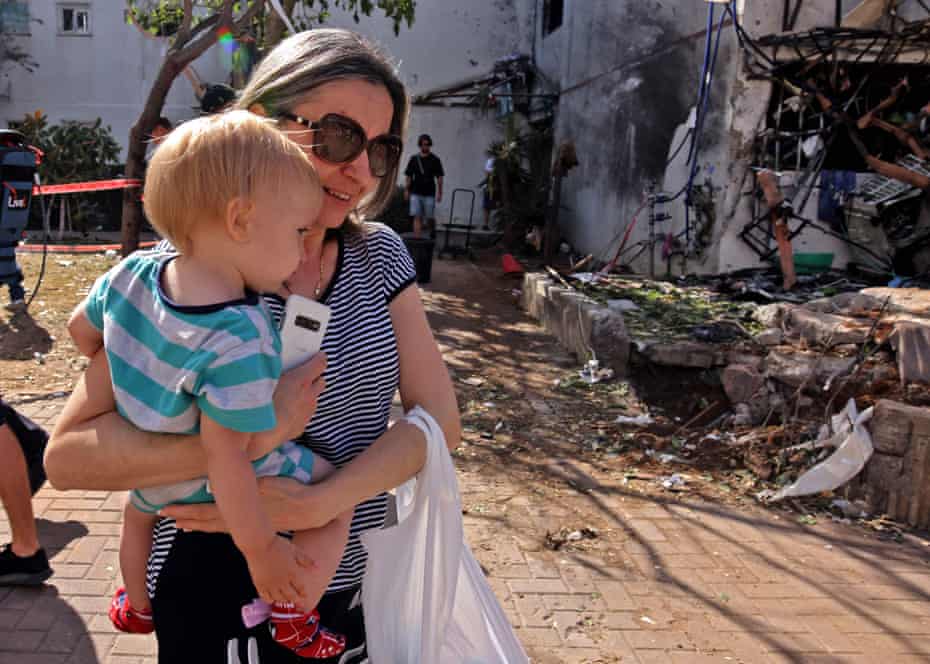
-
A woman carries her child outside a building that received a direct hit by rockets from the Gaza Strip, in the southern Israeli city of Ashdod on Monday. Photograph: Ahmad Gharabli/AFP/Getty Images
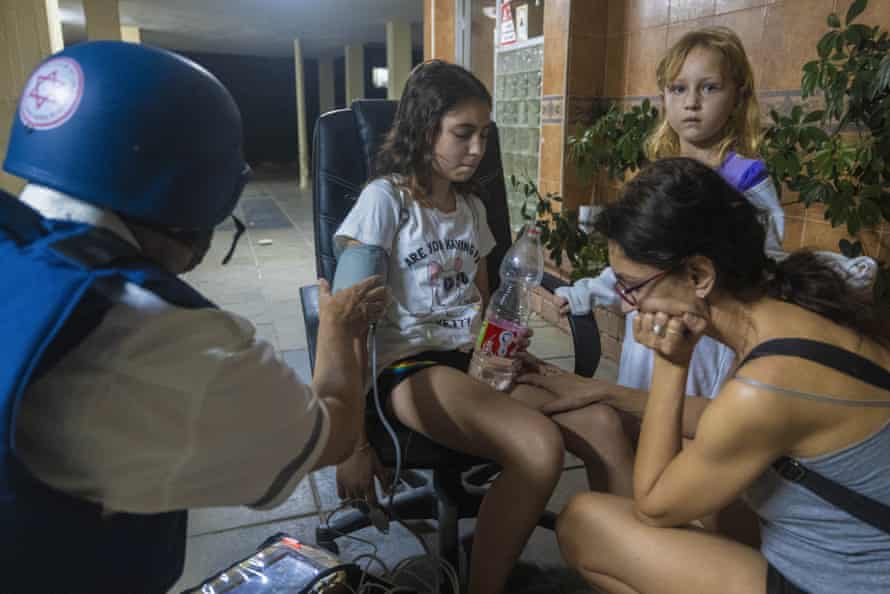
-
An Israeli paramedic checks the blood pressure of a young girl in a residential building after it was hit by a rocket fired from the Gaza Strip, in Ashkelon, southern Israel. Photograph: Tsafrir Abayov/AP
Israeli children have also been victims of the conflicts. Two have been killed by rockets fired from Gaza in the latest fighting, and over the years thousands have been traumatised by air raid sirens, explosions and panicked evacuations to bomb shelters.
In Gaza, a study conducted by Unicef following the 2012 conflict found that 91% of children reported sleeping disturbances during the conflict; 94% said they slept with their parents; 85% reported appetite changes; 82% felt angry; 97% felt insecure; 38% felt guilty; 47% were biting their nails; 76% reported itching or feeling ill; and 82% were either continuously or usually in fear of imminent death.

-
Palestinian children sit in the back of a van loaded with salvaged belongings from their home at the al-Jawhara Tower in Gaza City, which was heavily damaged in Israeli airstrikes. Photograph: Anas Baba/AFP/Getty Images

-
A Palestinian civil defence team carries a wounded girl after an Israeli airstrike in Gaza City on Sunday. Photograph: Mohammed Saber/EPA
Some of those traumatised in earlier wars were being helped to deal with their fears and anxieties by NGOs working in Gaza, such as the Norwegian Refugee Council. On Tuesday, it reported that 11 of the children killed in the current round of fighting had been enrolled in its psychosocial remedial programme. Among the 11 was one of Suzy Eshkuntana’s sisters.
Aged between five and 15, the children died “while they were at home and thought they were safe”, said Jan Egeland, the NRC’s secretary general. “They are now gone, killed with their families, buried with their dreams and the nightmares that haunted them.
“We call on Israel to stop this madness. Children must be protected. Their homes must not be targets. Schools must not be targets. Spare these children and their families. Stop bombing them now.”
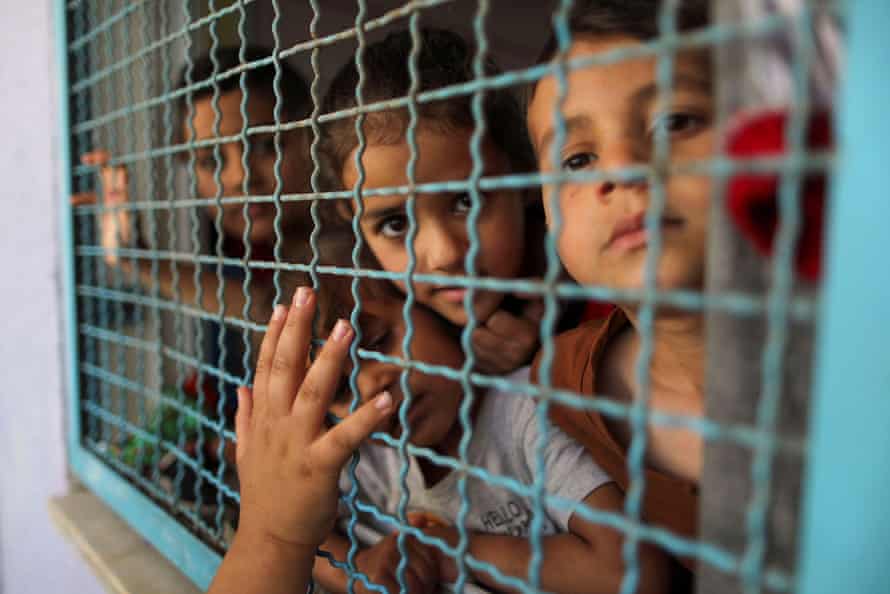
-
Palestinian children who fled their homes due to Israeli air and artillery strikes look through a window fence at a UN-run school where they take refuge, in Gaza City. Photograph: Suhaib Salem/Reuters
He added: “The truth is that there can be no peace or security as long as there are systemic injustices. The siege of Gaza needs to be lifted and the occupation of Palestinians must end if we are to avoid more trauma and death among children and new cycles of destruction every few years.”
After the last war in 2014, Hasan Zeyada, a psychologist with the Gaza Community Mental Health Programme, told the Guardian: “We are talking about a traumatised generation. They will perceive the world as dangerous, and they will have a lot of frustration and anger. And a desire for revenge … Israel is all the time in the process of creating a new generation of enemies.”
Israel says it does everything it can to prevent civilian casualties, including issuing warnings for people to evacuate buildings about to be struck. But Palestinians said there was no warning of the bombing that destroyed the Eshkuntana family’s home and many other buildings in an operation targeting a Hamas tunnel network.
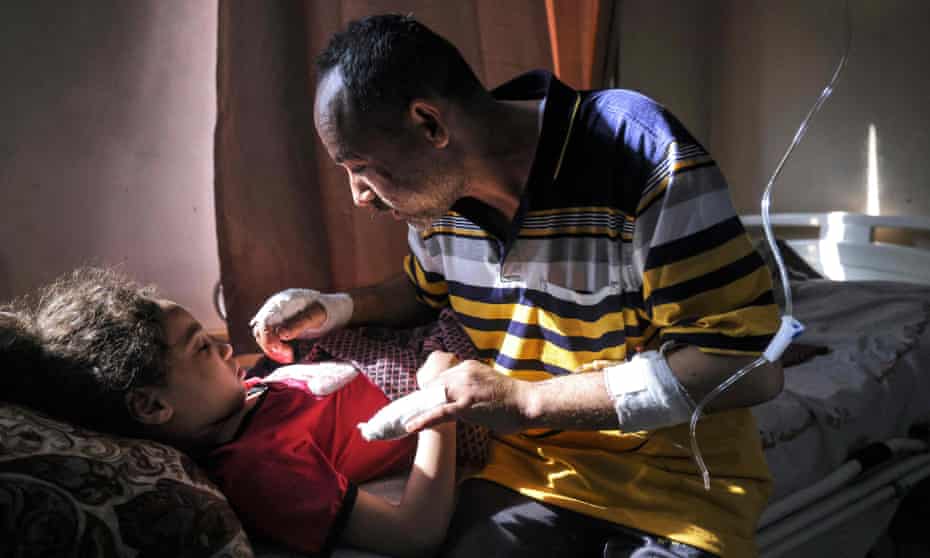
-
Ryad Eshkuntana checks his daughter Suzy as they received medical care at al-Shifa hospital on Wednesday. His wife and other children were killed in the Israeli airstrike. Photograph: Mahmud Hams/AFP/Getty Images
In the Shifa hospital in Gaza City, Suzy Eshkuntana is in “severe trauma and shock”, according to Dr Zuhair al-Jaro. She refused food at first, was mainly silent and rarely made eye contact with anyone. “She has entered into a deep depression,” he said.
The hospital had been unable to get her the psychological treatment she needed because of the fighting, said Jaro.
-
Associated Press contributed to this report.








